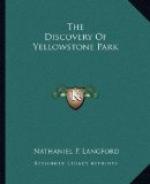N.P. LANGFORD.]
[Footnote H: Now Called Inspiration Point.]
[Footnote I: The above quotation is from a poem by John Keats.]
[Footnote J: Dr. P.V. Hayden, geologist in charge of the U.S. Geological Survey, first visited this region in the summer of 1871—the year following the visit of the Washburn party, whose discoveries and explorations are recorded in this diary. Dr. Hayden, on his return, graphically described the various wonders which he saw, but had very little to say concerning the mud volcano. This fact was the more inexplicable to me for the reason that the Washburn party thought it one of the most remarkable curiosities to be found in that region, and I was greatly surprised to find that Dr. Hayden made so little allusion to it.
In 1872, the year following Dr. Hayden’s first visit, I again visited the volcano, and the omission by Hayden was explained as soon as I saw the volcano in its changed condition. The loud detonations which resembled the discharges of a gun-boat mortar were no longer heard, and the upper part of the crater and cone had in a great measure disappeared, leaving a shapeless and unsightly hole much larger than the former crater, in which large tree-tops were swaying to and fro in the gurgling mass, forty feet below—the whole appearance bearing testimony to the terrible nature of the convulsion which wrought such destruction. Lieutenant Doane, in his official report to the War Department, thus describes the volcano as it appeared in 1870:
“A few hundred yards from here is an object of the greatest interest. On the slope of a small and steep wooded ravine is the crater of a mud volcano, 30 feet in diameter at the rim, which is elevated a few feet above the surface on the lower side, and bounded by the slope of the hill on the upper, converging, as it deepens, to the diameter of 15 feet at the lowest visible point, about 40 feet down. Heavy volumes




